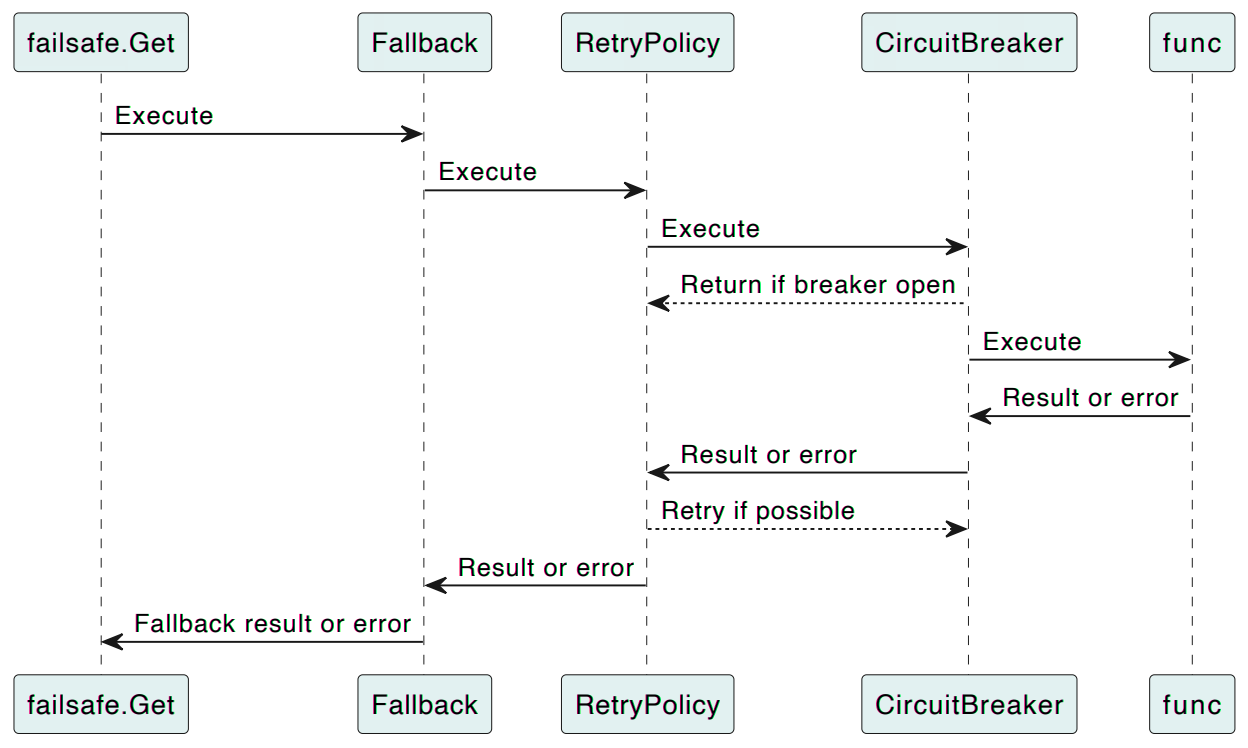Policies
Failsafe-go provides numerous resilience policies. While each policy handles failures in different ways, some of their common features are described below.
Failure Handling
Policies add resilience by detecting failures and handling them. Each policy determines which execution results, errors, or conditions represent a failure and how to handle them.
Some policies, such as a Retry, Circuit Breaker, Adaptive Throttler, and Fallback, allow you to specify which errors or results to handle as failures. By default these policies handle any error that is returned. But they can be configured to handle more specific errors, error types, or results:
builder.
HandleErrors(ErrClosed, ErrShutdown).
HandleErrorTypes(net.OpError{}, new(net.Error)).
HandleResult(nil)
They can also be configured to handle specific conditions:
builder.HandleIf(func(response *http.Response, err error) bool {
return response != nil && response.StatusCode == 500
})
If multiple handle methods are configured, they are logically OR’ed. The default error handling condition is only replaced by another condition that handles errors. A HandleResult setting will not replace the default error handling.
Policy Composition
Policies can be composed in any way desired, including multiple policies of the same type. Policies are composed around a function from left to right, similar to have function composition works, where the inner-most policy handles a function result first. For example, consider:
failsafe.With(fallback).
Compose(retryPolicy).
Compose(circuitBreaker).
Compose(timeout).
Get(fn)
The same statement can also be written as:
failsafe.With(fallback, retryPolicy, circuitBreaker, timeout).Get(fn)
This results in the following composition when executing the fn and handling its result:
Fallback(RetryPolicy(CircuitBreaker(Timeout(fn))))
Executing a Policy Composition
The process for executing a policy composition begins with Failsafe-go calling the outer-most policy. That policy in turn calls the next inner policy, and so on, until the user-provided func is reached. A result or error is returned back through the policy layers, and handled if needed by any policy along the way.
Each policy makes its own decision to allow an execution attempt to proceed and how to handle an execution result or error. For example, a RetryPolicy may retry an execution, which calls the next inner policy again, or it may return the result or error. A CircuitBreaker may return an error before an execution attempt even makes it to the func.
Example Execution
Consider an execution of the following policy composition:

Getcalls theFallbackFallbackcalls theRetryPolicyRetryPolicycalls theCircuitBreakerCircuitBreakerreturnsErrOpenif the breaker is open, else calls thefuncfuncexecutes and returns a result or errorCircuitBreakerrecords the result as either a success or failure, based on its configuration, possibly changing the state of the breaker, then returnsRetryPolicyrecords the result as either a success or failure, based on its configuration, and either retries or returnsFallbackhandles the result or error according to its configuration and returns a fallback result or error if neededGetreturns the final result or error to the caller
Composition and Error Handling
While policies handle all error instances by default, it’s common to configure a policy to handle more specific errors, as described above:
policyBuilder.HandleErrors(ErrClosed)
But when doing so for a policy that is composed around other policies, you may want to also configure an outer policy to handle errors returned by any inner policies, depending on your use case:
policyBuilder.HandleErrors(
retrypolicy.ErrExceeded,
circuitbreaker.ErrOpen,
timeout.ErrExceeded
)
Composition Recommendations
A common policy composition ordering might place a Fallback as the outer-most policy, followed by a CachePolicy, a RetryPolicy or HedgePolicy, a CircuitBreaker, AdaptiveLimiter, AdaptiveThrottler or RateLimiter, a Bulkhead, and a Timeout as the inner-most policy:
failsafe.With(fallback, cachePolicy, retryPolicy, circuitBreaker, bulkhead, timeout)
That said, it really depends on how the policies are being used, and different compositions make sense for different use cases.
Policy Sharing
All policies are safe to share across different executions. While some policies such as Retry Policy stateless, others such as Circuit Breaker, Adaptive Limiter, Adaptive Throttler, Rate Limiter, and Bulkhead are stateful, and are meant to be shared across different executions that access the same resources.
Mixing Result Types
When composing shared policies, it’s common for the shared policy to have any as the result type. These can be composed inside policies with specific result types:
circuitBreaker := circuitbreaker.NewWithDefaults[any]()
retryPolicy := retrypolicy.NewWithDefaults[Connection]()
// Compose RetryPolicy[Connection] around CircuitBreaker[any]
failsafe.With(retryPolicy).ComposeAny(circuitBreaker)
Or they can be composed outside other policies:
// Compose CircuitBreaker[any] around RetryPolicy[Connection]
failsafe.WithAny[Connection](circuitBreaker).Compose(retryPolicy)
Supported Policies
Read about the built-in policies that Failsafe supports:
- Retry
- Circuit Breaker
- Adaptive Limiter
- Adaptive Throttler
- Rate Limiter
- Timeout
- Fallback
- Hedge
- Bulkhead
- Cache